This collagen hot chocolate is the ultimate way to warm up your day while nourishing your body with added health benefits. Unlike many protein powders, 100% collagen provides a clean and straightforward ingredient profile, delivering a pure and luxurious cocoa experience. You can use dairy milk for a classic option or opt for unsweetened nut milk to keep it paleo-friendly.
Protein powders often contain added flavors, sweeteners, or emulsifiers, which can drastically change the flavor and texture. By focusing solely on collagen, you can enjoy a creamy, velvety hot chocolate that tastes just as indulgent as it feels nourishing.
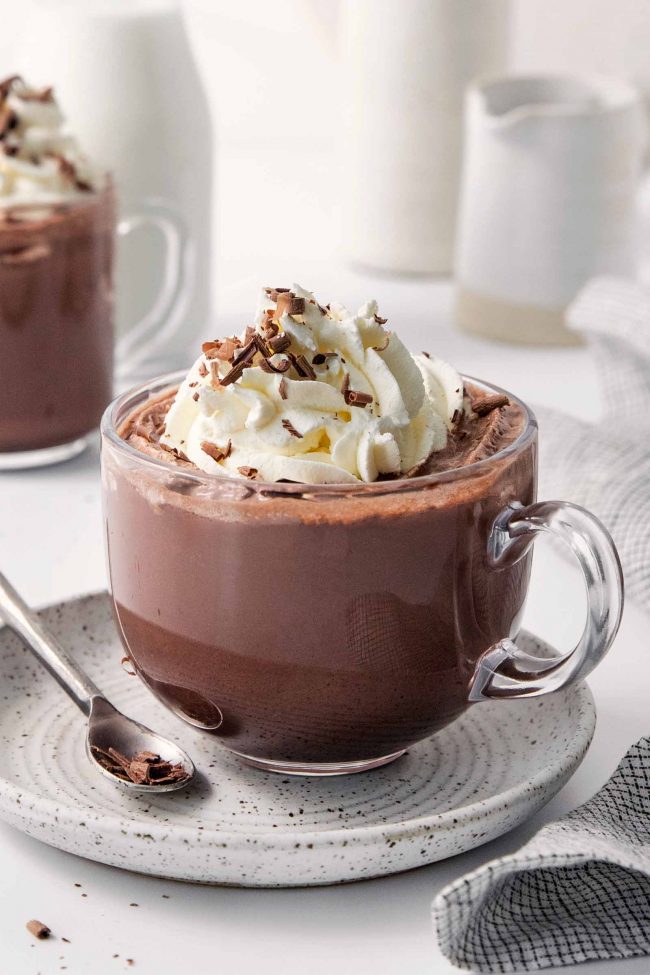
Ingredients
- Collagen powder – provides a boost of protein and supports joint, skin, and hair health without altering the flavor. You can omit this, if you’d like, and use the lower amount of sweetener listed.
- Cocoa powder – I talk about Dutch-process vs. natural cocoa below.
- Sugar or maple syrup – or really any type of sweetener.
- Milk of choice – anything goes except for canned coconut milk, as the flavor is too strong. In my Vegan Hot Chocolate Recipe, I used a 50/50 mix of canned coconut milk and unsweetened cashew milk. That worked great, and I’m guessing a 50/50 mix would work well in today’s recipe, too.
- Vanilla extract – or any type of extract you’d like.
- Salt – a pinch balances the sweetness and elevates the chocolate notes. If the hot chocolate tastes a bit flat, just add a bit more salt.
If you’re interested in experimenting with alternative ingredients like carob powder or coconut cream, be sure to check out my Frothed Hot Chocolate recipe. In that post, I dive into the various ingredient combinations I tested, sharing what worked beautifully and what fell short.
The base of that recipe is identical to today’s, just without the collagen. It’s my favorite non-special occasion hot chocolate recipe (if you want something more decadent, try this Christmas Hot Chocolate or Paleo Hot Chocolate), and I was thrilled to discover that adding collagen didn’t require any other adjustments — it works perfectly as is!
Since incorporating collagen, this has become my go-to method. I use an electronic frother because I love the creamy froth it creates, and it’s incredibly convenient to add all the ingredients and let the frother do the work for me.
If you don’t have a frother, no worries because today’s recipe includes easy stovetop directions to ensure everyone can enjoy it!
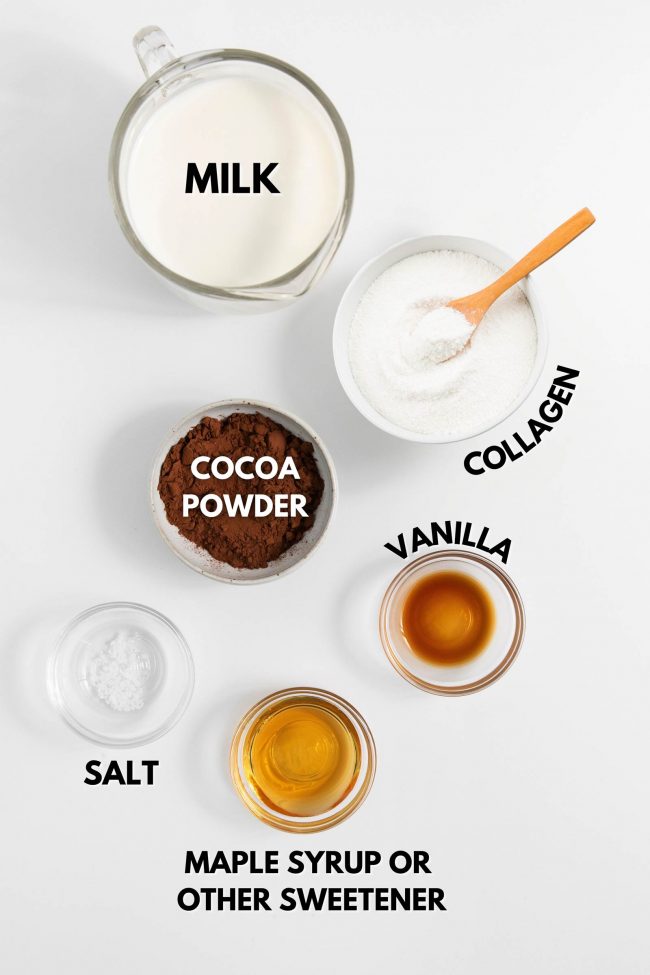
Cocoa powder type
I always make hot chocolate with Dutch-process cocoa powder but just tried it out with natural cocoa powder. Wow!
That was not good. It could be that I’m so used to Dutch-process cocoa powder hot chocolate that I’ve forgotten what regular hot chocolate tastes like.
It was much too tangy for my liking. Even after adding more sweetener, I didn’t like it.
Dutch-process cocoa is treated with an alkalizing agent to neutralize its acidity. This makes it smooth, mellow, and less bitter, with a rich, chocolatey depth.
Natural cocoa powder is untreated and retains its natural acidity. It’s bright, bold, and slightly tangy and bitter. Natural cocoa’s acidity can make the hot chocolate taste less sweet, even if the same amount of sweetener is used.
Wondering about cacao powder? In my cacao vs. cocoa post, I break down the key differences between the two. While cacao could work in this recipe, you’ll likely need to add significantly more sweetener to balance its intense flavor.
Based on my experience, recipes where I substituted cacao typically required about 33% more sweetener for the same level of sweetness.
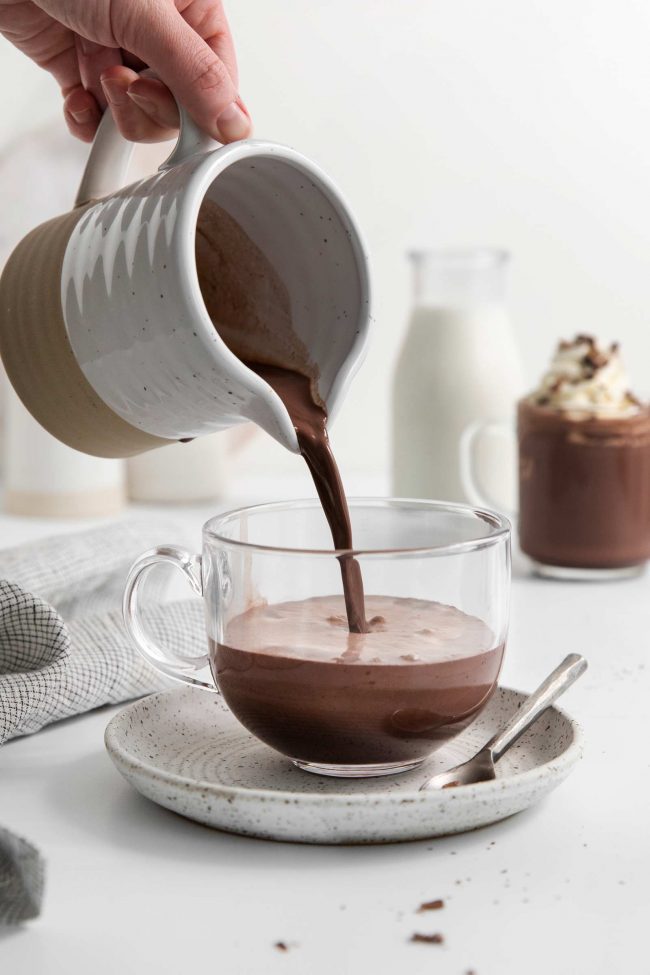
Collagen type
I always use Zint Collagen Peptides. I read here that it tested very clean.
I read there and several other places that Vital Proteins didn’t get such good results. But I, of course, still have about 4 pounds I bought when I had a good coupon.
I tested it in this hot chocolate, and it tastes exactly the same as the Zint version. I’m guessing any 100% collagen powder would work well in this recipe!
Can you taste the collagen?
One of the biggest concerns when adding collagen to beverages is whether you’ll notice its taste. The good news is that in this collagen hot chocolate, the flavor of the collagen is undetectable. The rich cocoa and creamy milk completely mask any hint of collagen, leaving you with a decadent, chocolatey drink.
Collagen is naturally flavorless, but some brands may have a slight aftertaste depending on their processing methods. To ensure the best results, opt for high-quality, 100% collagen peptides because these are more likely to dissolve smoothly and remain neutral in flavor.
Don’t use collagen protein powders, which often contain additional ingredients that would almost definitely alter the taste and texture of your hot chocolate.
How to make ahead
You can prepare a powdered version of this recipe (details below) and store it in an airtight container for up to 3 months.
You can also make a quadruple batch of the hot chocolate, cover leftovers and refrigerate for up to 4 days. Reheat gently on the stovetop or in the microwave.
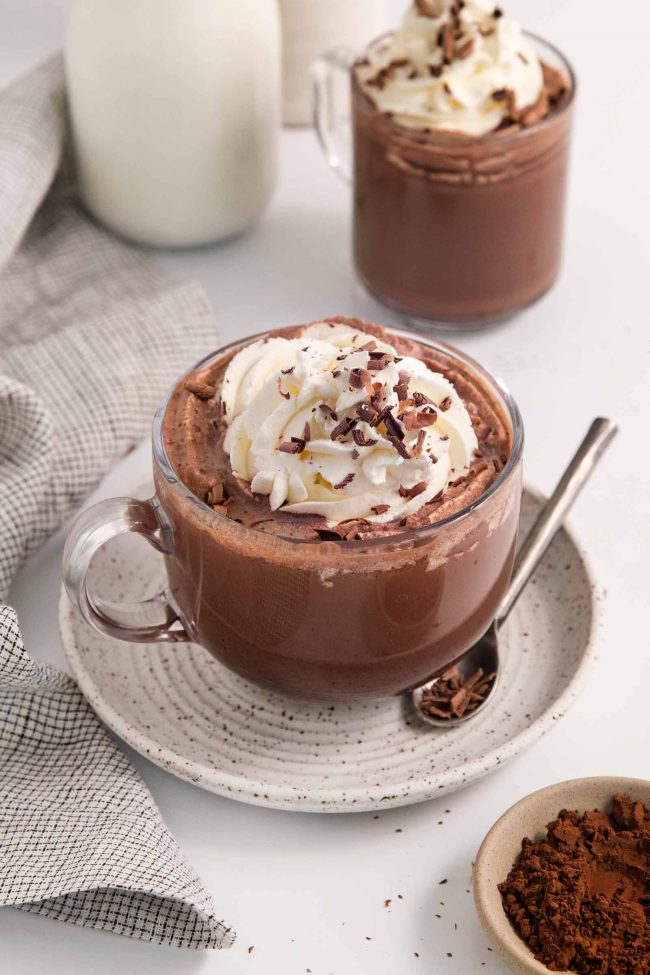
Big batch powder mix
Create a big-batch collagen hot chocolate mix for effortless preparation. The below is enough for 8 cups of hot chocolate.
Combine all ingredients and store in an airtight container. This uses the lower amount of sugar called for. If you know you want it sweeter (I know I do!), then add 2/3 cup (166 grams) of granulated sugar.
- 2/3 cup (71 grams) collagen powder
- 1/2 cup (65 grams) Dutch-process cocoa powder
- 1/2 cup (100 grams) granulated sugar or coconut sugar (or omit and add 3-4 teaspoons maple syrup when mixing up the hot chocolate)
- 1/2 teaspoon salt
Simply add 1/2 cup (120 ml) milk and a teaspoon of vanilla to 3 tablespoons + 1 teaspoon of the powdered mix to make a single serving.
If you omitted the sugar in the mix because you want to use maple syrup, then you only need 2 tablespoons + 1 teaspoon of the mix. And then add 3-4 teaspoons of maple syrup.
If you used 2/3 cup of granulated sugar in the mix instead of 1/2 cup, then add 2 tablespoons + 2 teaspoons of the mix.
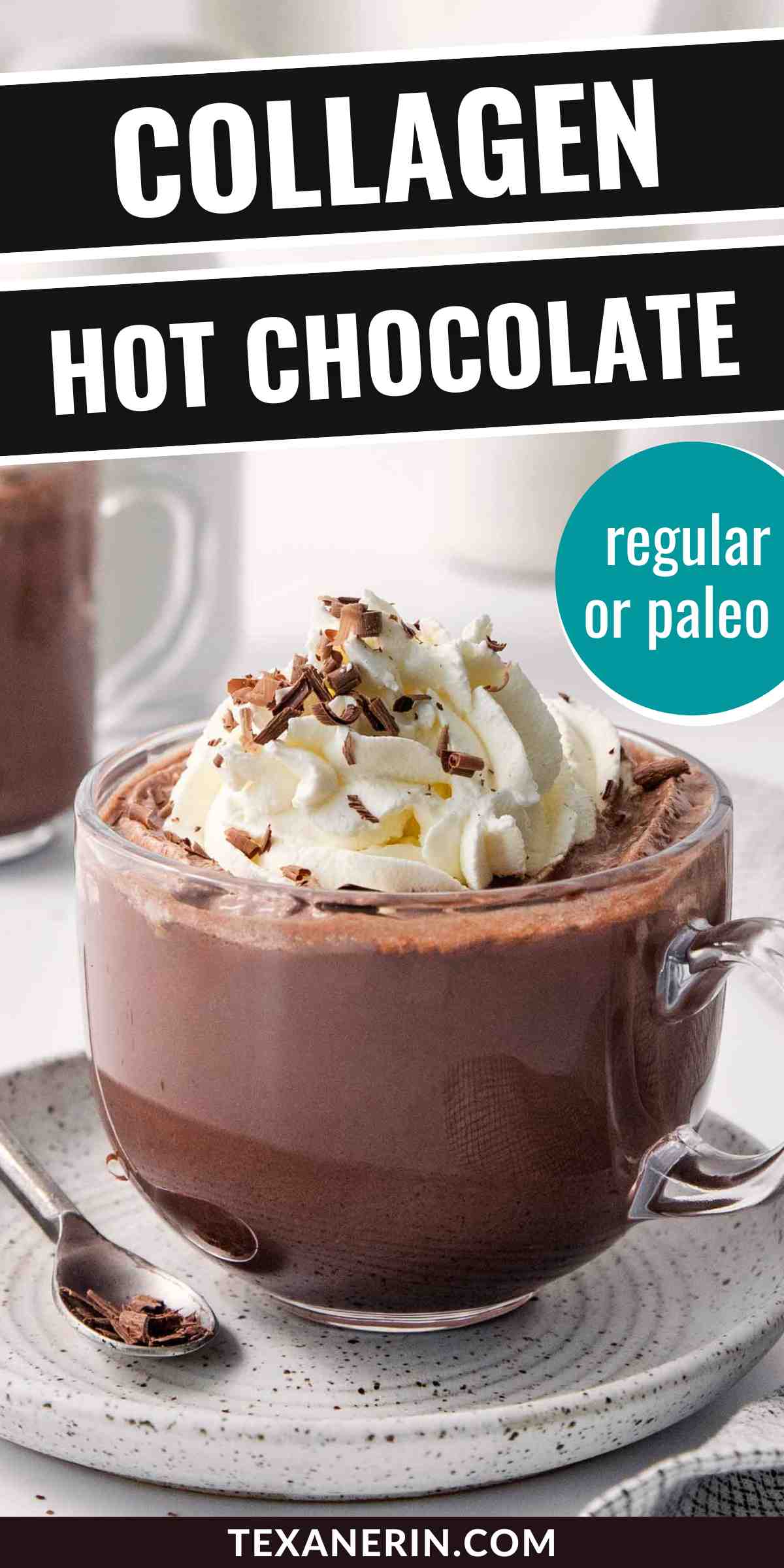
Paleo option
This is an easy recipe to make paleo and how I always make mine. All you need to do is make sure to use nut milk that’s just nuts, salt and water. No funky stuff.
Also use coconut sugar or maple syrup as the sweetener.
The 100% collagen powder I’ve bought has always been paleo, but perhaps they’re adding weird stuff to it nowadays. So be sure to check the label!
And as I said above, you’re looking for just collagen peptides. Not collagen plus additional sweeteners or flavors.
I hope you’ll enjoy this collagen hot chocolate! I’d love to hear your thoughts in the comments below. Thanks for reading! 🙂
❀

- Prep Time:
- Cook Time:
- Ready in:
- Yield: 1
Ingredients
- 4 teaspoons (9 grams) 100% collagen peptides
- 1 tablespoon (9 grams) cocoa powder (I recommend Dutch-process)
- 3-4 teaspoons granulated sugar, coconut sugar or maple syrup
- 1/2 cup (120 ml) milk of choice
- 1 teaspoon vanilla extract
- pinch of salt
Directions
- In a small saucepan, whisk together the collagen, cocoa powder and granulated or coconut sugar, if using.
- Stir in the milk, maple syrup (if using), vanilla and salt.
- Heat over medium-high heat, stirring until the powder is completely dissolved and it’s hot enough for your liking.
- Add all of the ingredients to an electric milk frother (add the milk and then all the rest). Froth for 45 second or until it turns off if you have a frother that turns off automatically when it’s done frothing. If you have different settings, choose one that heats and froths.
- Cool, cover leftovers and refrigerate for up to 4 days. Reheat gently on the stovetop or in the microwave.
Stovetop directions:
Frother directions:
How to store:
Notes
- For a paleo version, use nut milk with only nuts, salt and water in it. Use coconut sugar or maple syrup instead of granulated sugar.

